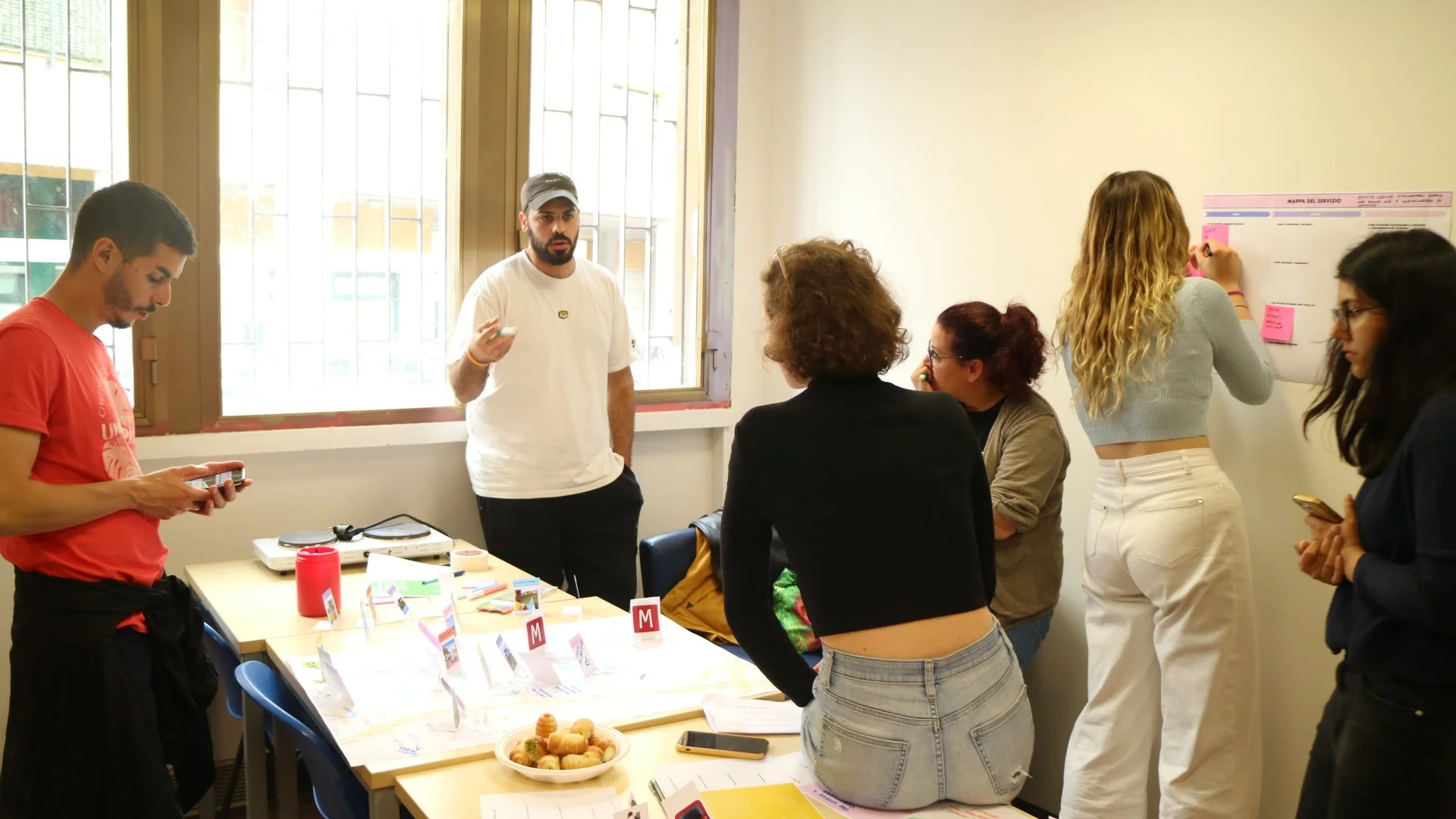Analysing the state of public transport and ridehailing in Karachi from a systemic design lens
Ridehailing in Karachi
My role
Service designer, design researcher,
project lead
Project type
Professional project @Designist, 2 months (2019)
Team members
5 interns (service designer, illustrator, graphic designer)
Design & research methods
Interviews, observations, system map, causal layered analysis, futures triangle, giga map
Project
Exploring Karachi’s ride hailing landscape for the middle class through systemic design, to analyse the current social, economic and environmental factors and project future patterns
Investigate Karachi’s ride hailing landscape for the middle class through a systemic design lense?
Analyse the current social, economic and environmental factors regarding transportation and ride hailing?
Project future patterns based on the analysis?
How might we:
Outcome
A new service concept for the CAG of Ponte Lambro, namely Oasis Ponte Lambro. Customer Journey Maps, System Maps, Storyboards etc. were also part of the outputs that helped narrate the story of the redesigned service of CAG Ponte Lambro.
Impact
The project was presented to the Municipality of Milan and the Councillor and CAG representatives (including the CAG representative from Ponte Lambro). The Municipality of Milan reflected their intention of implem-enting some of the suggestions.
Context
Karachi is the most populous city in Pakistan, with a population of about 22 million people. Having multiple layers and nuances, the problem of transportation in Karachi is a “wicked problem”. The hypothesis for this research project was that Karachi’s transport landscape may benefit from a comparison between digital ride hailing services such as Careem, Uber and Bykea, and traditional modes of public transportation (nondigital ride hailing services) like buses, rickshaws, qingqis and taxis.
The data gathered for this study included a combination of primary data in the form of interviews and observations, as well as secondary information in the form of case studies, reports & data statistics. In total, 49 people were interviewed, which included people who are regular users of the ride hailing services, drivers of various transportation modes, traffic policemen and experts from the field of transportation.
Research
Research Methods
Observations
Interviews
Case-study
Analysis
Desk Research


Research Insights
The youth workers at the CAG challenge stereotypes to build meaningful relationships with the kids and transform Ponte Lambro.
"When explaining to my friends what I do for a living, they say 'so you work with problematic children'. I think they have problems, I have problems, you have problems too. The idea that this is a place for problematic kids is wrong."
- Aaron, CAG coordinator
Teenagers doing different activities at the CAG
The CAG is essential for Ponte Lambro because it fosters community cohesion and support.
“The real mission is to try to hold the pieces together, to keep the social hold of a context together, by investing in the young people of this context.”
- Aaron, CAG coordinator
Coming up with new services and activities at Ponte Lambro CAG involves a trial-and-error process.
"I can't tell you what can be functional right now, but in my opinion it certainly needs to be reviewed from time to time, from generation to generation."
- Ilenia, Youth Worker
There is an abundance of green and open spaces in the neighborhood which are not used to their full potential.
“The neighborhood is beautiful, we have parks and the Ponte bridge. Compared to the centre of Milan which is more crowded, we have a closer connection to nature. However, these spaces are often empty and unused. ”
- A resident
Empty green spaces in the neighborhood
“The kids who attend the center are mainly Italian, even if we have different origins we are all Italian because we all go to school together, it doesn't matter if their parents came from another country.”
- A local teenager
The youth from Ponte Lambro is the key to integration of immigrants in the neighborhood.
There is criminal activity in the area which has made the neighborhood notorious. The youth of Ponte Lambro want to move away because they don’t see a future there.
“Children in the evening cannot play in the park, there are drunk and drugged people. The situation is unsolvable because the police are afraid, they drive by but don't stop.”
- A local teenager
There is a sense of isolation and abandonment in the neighborhood because of the highway which cuts the neighborhood from the rest of the city, the lack of services, lack of connectivity through public transport connectivity, and abandoned improvement projects.
“We are part of Milan but being divided from the city by the Tangenziale Est highway, we feel abandoned.”
- A local mother
“They throw us the hook, everyone takes the bait, but nothing ever gets done in the end. Everyone hopes for improvement, but there is one step forward and two steps back.”
- The baker
Dilapidated condition of public services (bike-sharing)
The abandoned Renzo Piano project in the area


Mess Map
The mess map was drawn based on the research insights to visualize the complexity and layers of transportation in Karachi. The primary and secondary causes and effects of the ride hailing situation in Karachi in 2019 were mapped out. The significant takeaways from using this tool were the interconnectivity of all positive and negative factors, how certain causes can be effects as well and vice versa. The map also made it apparent that other services and systems such as healthcare, policy making and urban planning influence the transportation and urban mobility in Karachi.
Ideation
How Might We statements were developed based on the research insights which were then collectively ideated upon by the research team. The ideas were later annotated with the 12 Leverage Points by Donella Meadows.
This is what we uncovered from the co-design session:
The participants preferred outdoor and sport-related activities that promote social interaction and effectively utilize the available green spaces and other facilities within the Ponte Lambro district.
OCCUPY THE NEIGHBORHOOD
PONTE LAMBRO COMES FIRST
The proposal to take youngsters out of Ponte Lambro was met with resistance, as the participants suggested that first the youth should take ownership of the neighborhood. Any improvement to the CAG should also result in bringing improvements to the community.
COMMUNITY-CENTRED SOLUTIONS
The participants emphasized the importance of involving all members of the community in neighborhood-based activities for the youth.


Outcome
WHAT IT IS:
Oasis Ponte Lambro
The project concluded in the form of a detailed 25,000 word report and a giga map. One of the key findings of this research was that transport related interventions should be planned and executed in a manner that is adaptable to the cultural values and conventions of the general public, and the current mobility patterns within the city.
Additionally, an important aspect that was observed for the duration of this project was the significance of both digital and non digital ride hailing services for commuters. This is because commuters have varying preferences based on comfort and cost of journey, and paired with a well-thought mass transit system this would have a considerable net positive effect on the transportation system in Karachi.
This video showcases the new concept addressing the problems currently present in Ponte Lambro.
Oasis Ponte Lambro has multiple offerings in its service, as showcased in the Offering Map.
WHO WILL BE INVOLVED:
WHAT KIND OF FLOWS WILL THERE BE BETWEEN STAKEHOLDERS:
WHO WILL BENEFIT FROM OASIS PONTE LAMBRO ?
PERSONA 01
The first persona is Michelle. This persona was inspired by a real CAG user that participated in the interviews and co-design workshop. She represents the main customer segment we are targeting, the youth from Ponte Lambro. Michelle is a 16 years old girl passionate about sports who wants to explore her neighborhood with her friends.
HOW WILL THE SERVICE FUNCTION?
STORYBOARD 01
This storyboard is based on the service offerings ‘Outdoor Moves’ and ‘Open Sessions’, and has the persona Michelle as the the protgonist. These activities will take place in the outdoor facilities and green areas of Ponte Lambro. The main offers are guided bike tours to discover the history and natural beauty of Ponte Lambro and open sessions of collective activities such as yoga and dance.
The main goal is to help the youth in releasing endorphins while exploring their neighborhood and connecting with it by learning its history.
DETAILS & TOUHCPOINTS
JOURNEY MAP 01
(Scroll to see all pages of the map)
WHO WILL BENEFIT FROM OASIS PONTE LAMBRO ?
PERSONA 02
The second persona is Alessandro. He is a 13 year old boy from Ponte Lambro that joined the CAG at the insistence of his parents, seeking help with homework. Alessandro is passionate about sci-fi, video games and he is super tech-savvy. However, he is not really into sports but wants to find new friends with similar interests.
HOW WILL THE SERVICE FUNCTION?
STORYBOARD 02
This storyboard is based on the service offering ‘Creative Challenges’, and has the persona Alessandro as the the protgonist. He participantes in a tech-treasure hunt in the park with augmented reality, artificial intelligence and sensors. The goal of this service offering is to get kids closer to nature and help them discover new passions other than sports.
DETAILS & TOUHCPOINTS
JOURNEY MAP 02
(Scroll to see all pages of the map)
Personal Reflections
What did I learn?
This was one of my first design projects in the context of Milan. I learnt:
How co-design can be an effective tool not only to understand the validity of concepts, but also to empower the involved stakeholders within the ideation, design and decision-making process
Service designers often have to go beyond the given brief and study in detail the context and root causes of a given problem
The value of a multi-cultural team & collaboration, since we were able to reduce the biases in our understanding and ideas by discussing and analysing as a team
Limitations of the project
There were a myriad of limitations in this project. Firstly, there was limited availability of the youth workers and the coordinator within the CAG, hence the research was not as detailed as we liked. Secondly, since we were working with minors, often we would only get to engage very few teenagers in our interviews/co-design, so we had to work with a limited sample size. Thirdly, the timelines of the course (within which we were doing this project) would not match the timelines and pace at which the CAG and the Municipality works. Hence the rushed pace of the course often affected the quality of the output.
What would I improve or change?
I would change the timeline of the project, so that more research sessions and co-design sessions can be held not only with the youth workers at the CAG but also with the parents and other community members of the neighborhood.






































